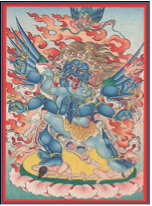

 My research demonstrate the existence of a large category of meditative techniques, which modulate attentional control by arousal-driven influences and not by monitoring continuous thought processes as during mindfulness-related practices. These include practices employed within Vajrayana (Tantric Buddhism), by Sufis of the Islamic tradition (“whirling dervishes”), and probably by a number of other traditions, including Hindu Tantra and East Asian martial arts. Not easily accounted for by the existing frameworks of mindfulness-related practices and being more culturally complex, these meditative practices, instead of relaxation, demonstrate an arousal response, which is a state of the autonomic nervous system (ANS), characterized by a withdrawal from parasympathetic (PNS) activity towards an enhanced sympathetic nervous system (SNS) tone. It is accompanied by phasic alertness – selective (focused) attention increments of short endurance – occurring in response to potential threat or novelty as a result of enhanced production of noradrenaline (NE) by the brainstem nucleus locus coeruleus (LC).
My research demonstrate the existence of a large category of meditative techniques, which modulate attentional control by arousal-driven influences and not by monitoring continuous thought processes as during mindfulness-related practices. These include practices employed within Vajrayana (Tantric Buddhism), by Sufis of the Islamic tradition (“whirling dervishes”), and probably by a number of other traditions, including Hindu Tantra and East Asian martial arts. Not easily accounted for by the existing frameworks of mindfulness-related practices and being more culturally complex, these meditative practices, instead of relaxation, demonstrate an arousal response, which is a state of the autonomic nervous system (ANS), characterized by a withdrawal from parasympathetic (PNS) activity towards an enhanced sympathetic nervous system (SNS) tone. It is accompanied by phasic alertness – selective (focused) attention increments of short endurance – occurring in response to potential threat or novelty as a result of enhanced production of noradrenaline (NE) by the brainstem nucleus locus coeruleus (LC).
 As arousal-based meditative practices are associated with a different autonomic state to mindfulness-related practices (PNS withdrawal vs. PNS dominance), they are likely to recruit a different type of alerting attention (selective or focused vs. sustained) and attentional control (modulated by arousal vs. regulated by monitoring continuous thought processes).
As arousal-based meditative practices are associated with a different autonomic state to mindfulness-related practices (PNS withdrawal vs. PNS dominance), they are likely to recruit a different type of alerting attention (selective or focused vs. sustained) and attentional control (modulated by arousal vs. regulated by monitoring continuous thought processes).
In particular, my focus is on Vajrayana (Tantric Buddhism) practices, during which a sequence of generation (self-visualization as a deity - Yidam) or completion with sign (inner heat -Tummo) stages necessarily precedes non-dual awareness (NDA) Tantric Mahamudra. I conduct my studies with experienced monks and nuns in Eastern Tibet, Bhutan, and Nepal. I studied these practices using cognitive (visual working memory and attention) assessments as well as electrocardiographic (EKG) and (EEG) measures.
 My research results show that both Yidam and Tummo are develop the state of arousal and phasic alertness (focused attention). Tummo lead to a paradoxically high arousal and the state of phasic alertness (selective focused attention), which is likely is a basis for core body temperature increases I observed in experienced tummo practitioners. Arousal developed using both Yidam and Tummo leads to what I termed Enhanced Cognitive States, the states of dramatically boosted focused attention, similar to the state described as “flow” which is experienced during challenging and exiting activities such as gaming, tock-climbing, extreme sports, and others. Later, the state developed by Yidam and/or Tummo is neurophysiologically employed in Tantric Mahamudra, leading to the unique state of high cortical excitability, “non-selective” focused attention, and significantly reduced attentional control. This is in contrast of non-Tantric (mindfulness) style of Mahamudra, practiced in a relaxed state by some Tibetan traditions, performed in a state of PNS dominance, tonic alertness, and active monitoring.
My research results show that both Yidam and Tummo are develop the state of arousal and phasic alertness (focused attention). Tummo lead to a paradoxically high arousal and the state of phasic alertness (selective focused attention), which is likely is a basis for core body temperature increases I observed in experienced tummo practitioners. Arousal developed using both Yidam and Tummo leads to what I termed Enhanced Cognitive States, the states of dramatically boosted focused attention, similar to the state described as “flow” which is experienced during challenging and exiting activities such as gaming, tock-climbing, extreme sports, and others. Later, the state developed by Yidam and/or Tummo is neurophysiologically employed in Tantric Mahamudra, leading to the unique state of high cortical excitability, “non-selective” focused attention, and significantly reduced attentional control. This is in contrast of non-Tantric (mindfulness) style of Mahamudra, practiced in a relaxed state by some Tibetan traditions, performed in a state of PNS dominance, tonic alertness, and active monitoring.
Relevant research articles: